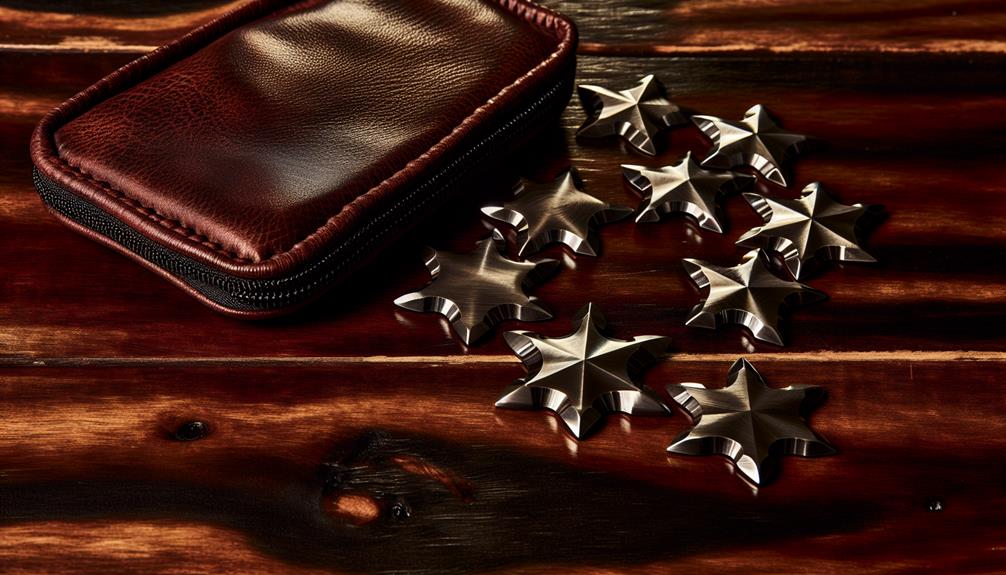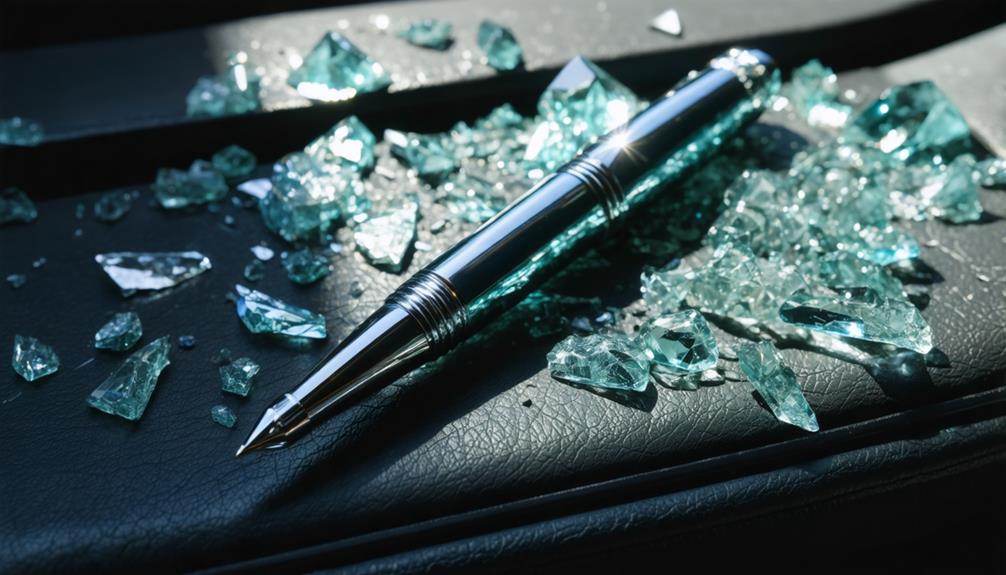
Brainstorm Security Shop

For Orders Over $199

On Any Of Our Products

Details On Refund Page
When you’re serious about practicing with throwing stars, or shuriken, don’t you think it’s crucial to consider how you’re transporting and storing them? A proper carrying case not only ensures your safety but also maintains the condition of your tools. Imagine a case designed with robust materials and tailored compartments that perfectly fit your set, safeguarding each star from damage and corrosion. But how do you pick the right one among so many options? Let’s explore the factors that determine the best choice for securing your throwing stars, ensuring that each element of the case aligns with your needs.
Throwing stars, also known as shuriken, originated in Japan during the feudal era. As you delve deeper into their history, you’ll discover their profound cultural significance and integral role in martial arts.
Initially crafted by ninjas, these tools weren’t just weapons but symbols of resistance and strategy. They represented a warrior’s skill and stealth, qualities highly prized in Japanese culture.
You might think of them merely as cool, sharp objects seen in movies, but their real story is much more complex. In historical contexts, shuriken were used not only for combat but also for distraction and signaling. They were a crucial part of the ninja‘s arsenal, allowing for silent, swift actions that aligned with the secretive nature of their missions.
Understanding the cultural backdrop of martial arts in Japan, you realize that these throwing stars weren’t merely tools of war but also instruments of peace and protection. They embodied the philosophy of using one’s skills for greater good, a testament to their enduring legacy in Japanese history.
Next time you see a throwing star, remember, you’re looking at a piece of cultural and martial heritage that has survived centuries.
As you explore the various types of throwing stars, you’ll find that historical designs offer a glimpse into the past, while modern materials and techniques provide enhanced performance.
You’ll also notice a range of popular shapes, each tailored for specific tactical advantages. Understanding these differences can significantly impact your choice and use of throwing stars.
Throughout history, various types of throwing stars, also known as shuriken, have been developed and utilized in different cultures. You’ll find that these ancient designs weren’t just tools of war; they held deep cultural significance. Each form and style of the shuriken tells a story about the people who crafted and used them.
In Japan, the art of the shuriken is closely linked to the ninja, who adapted tools from everyday life for defense. These stars weren’t just weapons but symbols of resistance and ingenuity. The most recognized types include the hira-shuriken, or flat-plate type, and the bo-shuriken, resembling spikes. The hira-shuriken often features multiple points and is crafted to spin through the air, while bo-shuriken are thrown like darts.
These stars weren’t only practical in silent warfare but also served as emblems of the secretive lives of their wielders. The designs varied widely from region to region, reflecting local materials and martial traditions. Understanding these variations helps you appreciate the depth of skill and tradition embedded in each piece.
As you explore these historical designs, remember you’re delving into a rich tapestry of ancient martial arts culture, each star carrying the legacy of its creators.
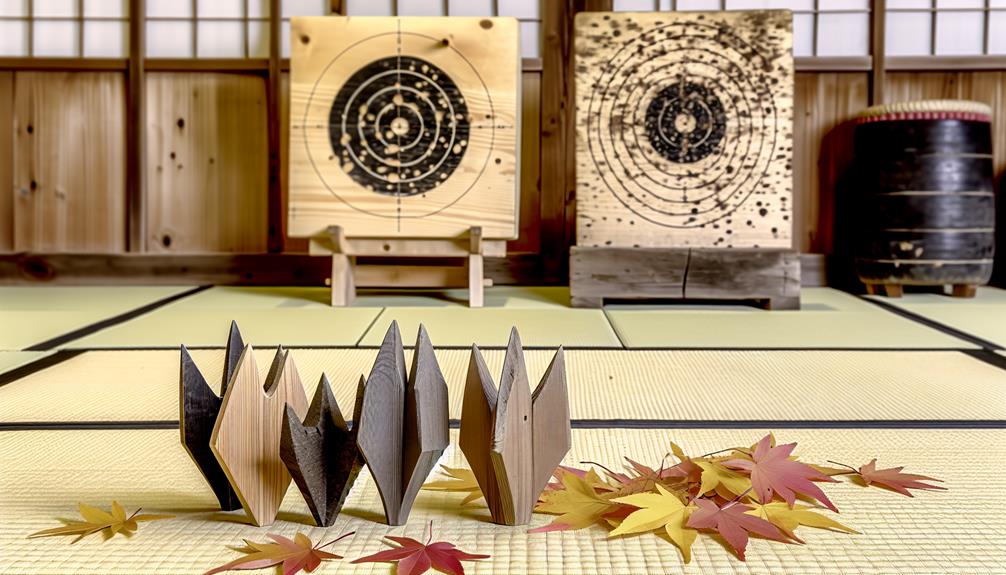
Today’s throwing stars are crafted from advanced materials like high-grade stainless steel and durable plastics, ensuring they’re tougher and more resistant to wear than their historic counterparts.
With the aid of advanced manufacturing techniques, you can now access throwing stars that combine exceptional durability with a level of precision craftsmanship that old-world smiths could only dream of. These materials aren’t just tough; they’re also designed to maintain their balance and sharpness even with repeated use, giving you a reliable tool in your throwing practice.
Innovative designs have also emerged, pushing the boundaries of what you might expect from throwing stars.
Modern engineering allows for intricate weight distribution and aerodynamic profiles that enhance the throwing experience. You’ll find that these stars fly with a predictable trajectory and consistent rotation, thanks to the precise calculations that go into their design.
Whether you’re a seasoned practitioner or a beginner, the combination of advanced materials and state-of-the-art manufacturing processes means you’re handling a product that’s built to meet the demands of modern throwing techniques.
These aren’t just tools; they’re carefully engineered pieces of art that reflect the pinnacle of what current technology can achieve in the realm of throwing stars.
Modern throwing stars aren’t just about the materials and technology; their shapes also play a vital role in performance. You’ll find that the geometry of each design impacts both throwing star functionality and aesthetics. Whether you’re a beginner or a seasoned ninja, understanding these popular shapes will enhance your throwing precision and style.
Here’s a breakdown of some common throwing star shapes:
| Shape | Points | Best for |
|---|---|---|
| Four-pointed | 4 | Beginners; balanced flight |
| Six-pointed | 6 | Intermediate; more impact |
| Eight-pointed | 8 | Advanced; precision throws |
| Shuriken | Varied | Stealth and surprise attacks |
Each shape has its unique advantages. The four-pointed star, for instance, is perfect if you’re just starting out. It’s easier to handle and tends to have a stable, predictable flight. As you advance, you might prefer the six or eight-pointed designs, which can improve your accuracy and increase the potential for sticking into the target due to their additional points.
Don’t just pick any star; consider how each design complements your technique and purpose. Whether you’re practicing in your backyard or involved in competition, the right throwing star can significantly affect your performance and results.
When selecting the right material for your throwing stars, consider both durability and weight. You’ll want a material that withstands repeated impacts without bending or breaking. Material properties such as hardness and tensile strength are vital to your star’s longevity and performance.
But it’s not just about toughness; weight balance is crucial. A star that’s too heavy might be hard to throw accurately, while one that’s too light may not travel effectively through the air. Metals like steel or titanium strike a good balance, offering both durability and a satisfying heft.
Steer clear of materials that are overly brittle or heavy, as these will hinder your throwing ability.
Choosing the right material also affects the handling and feel of your throwing stars. You’ll notice that different materials respond differently when thrown. Experiment with a few different types to see what feels best in your hand and suits your throwing style.
Remember, the right choice enhances your precision and the overall throwing experience.
Keep these points in mind, and you’ll find the material that best meets your needs, balancing durability, weight, and usability for optimal performance.
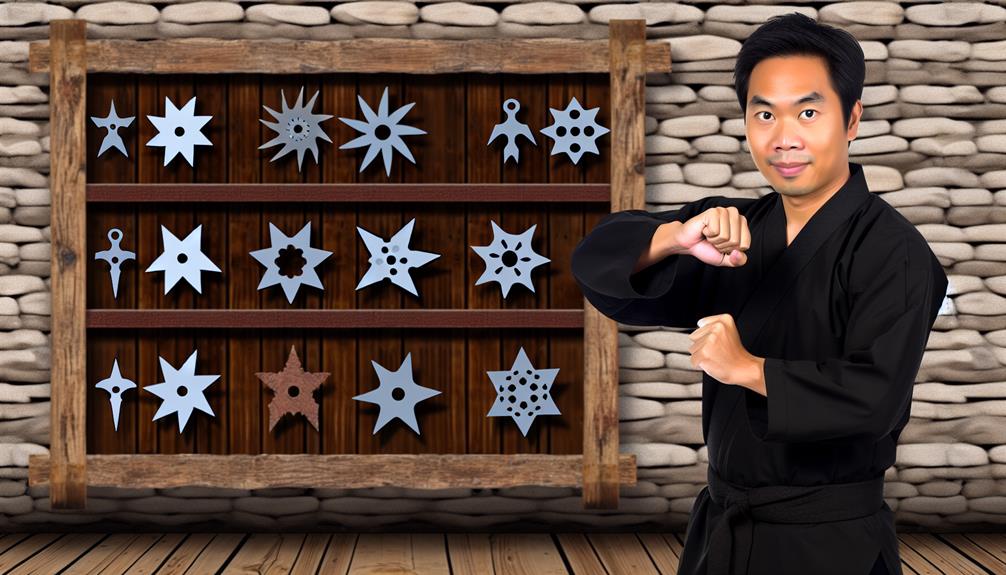
When selecting your throwing stars and carrying case, you’ll want to focus on material and durability to ensure long-term usability.
Consider the security features of the case to keep your stars safe and inaccessible to unauthorized users.
Lastly, assess compactness and portability, which will affect how easily you can carry them on the move.
The material and durability of throwing stars are crucial factors to consider before making a purchase.
You’ll want to focus on the material properties that ensure longevity and consistent performance. Most throwing stars are crafted from stainless steel or high-carbon steel, materials known for their strength and resistance to corrosion. The choice between them depends on your preference for weight and balance, as stainless steel is typically lighter.
Durability testing is another aspect you can’t overlook. This involves examining how well the throwing stars withstand repeated use and exposure to different environments.
You’d hate to have your stars bend or break just when you need them the most. Manufacturers often perform rigorous testing to simulate real-world conditions, so checking their testing protocols can give you a sense of reliability.
Often, you’ll find that the security features of a carrying case are just as important as the quality of the throwing stars themselves. When choosing a case, it’s crucial to consider what kind of lock mechanisms are in place. You’d want something secure, yet not overly complicated that it becomes a hassle to access your stars when you need them.
Look for cases with durable, tamper-proof locks. Combination locks are a popular choice since they eliminate the risk of losing keys and provide a decent level of security. However, key locks might appeal to you if you prefer physical keys over remembering codes.
The security materials used in the construction of the case also play a vital role. A robust hard-shell case made from high-impact plastic or reinforced metal can deter theft and protect your throwing stars from damage.
The interior should have a soft lining to prevent scratches and dents on your stars, while the exterior should be tough enough to withstand attempts at forced entry.
Investing in a case with these security features ensures that your throwing stars are protected not only from the elements but also from theft and unauthorized access.
Make security as much a priority as durability when picking out your case.
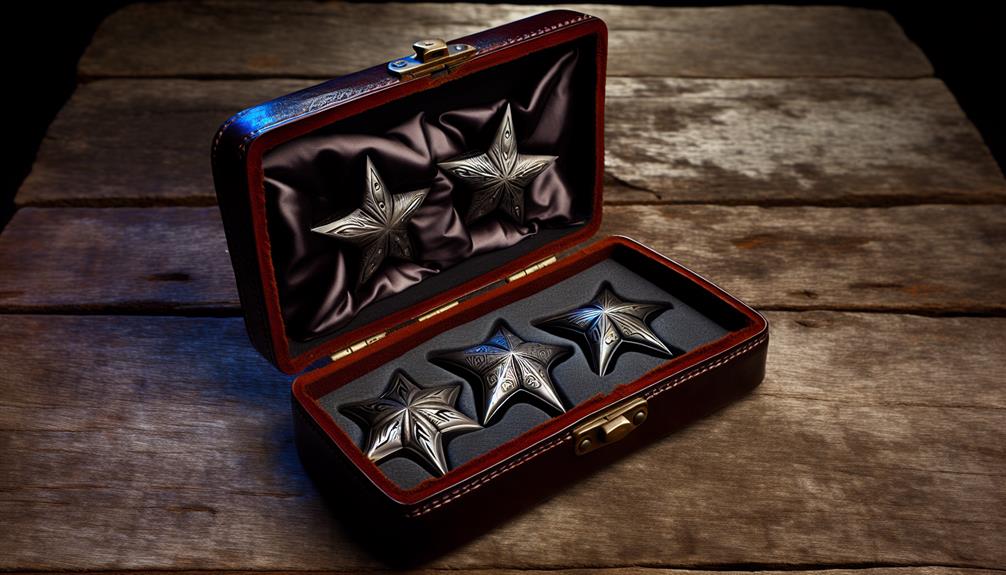
Considering your need to easily carry and access your throwing stars, designing the case for compactness and portability is crucial.
You’ll want a case that doesn’t just protect your stars but also fits comfortably into your travel gear. Opting for lightweight options can make a significant difference. A heavy case might slow you down, and that’s the last thing you need when mobility is key.
Look for materials that offer durability without the added bulk. High-grade plastics or composite materials are often your best bet, providing a sturdy yet light container.
The design of the case should also consider travel convenience. Imagine a case that can easily slip into your backpack or attach to your belt without causing discomfort.
Furthermore, the internal layout should maximize space without compromising on safety or accessibility. A well-designed case will have dedicated slots for each star, ensuring they remain secure and are easy to retrieve.
This setup not only protects your throwing stars from damage but also prevents them from clanging together, which could attract unwanted attention.
Compactness and portability aren’t just about making it easier to carry your equipment; they’re about enhancing your readiness and effectiveness wherever you go.
When handling throwing stars, always prioritize your safety by wearing protective gloves. It’s crucial to adopt safe practices to prevent injuries.
Begin by mastering the proper grip; this not only improves accuracy but also minimizes the risk of the star slipping and causing unintended harm. Select your targets carefully, ensuring they’re in a safe, controlled environment. Be constantly aware of your surroundings to avoid accidents.
Incorporate regular training drills to hone your skills and reinforce safety habits. These exercises should be performed under strict supervision, especially when you’re still learning the nuances of handling these weapons.
Always perform equipment checks before use to ensure no damaged or faulty stars are in play—it’s a simple step that’s critical for your safety.
Store your throwing stars in secure storage solutions when not in use. This precaution keeps them out of the wrong hands and maintains their condition.
Lastly, have a clear emergency response plan in place. Knowing how to react swiftly and effectively in case of an accident can significantly reduce the severity of injuries.
After discussing how to safely handle throwing stars, it’s equally important to consider how you store them. The right case isn’t just a nice-to-have; it’s a crucial component of your throwing star kit.
Let’s dive into why a dedicated case is so essential and the case benefits it offers.
First off, a case provides organized and secure storage solutions. You don’t want your stars jumbling around in a drawer or bag where they can get damaged or cause injury. In a case, each star has its own slot or compartment, keeping them in pristine condition and ready for use at a moment’s notice.
Moreover, a case protects your throwing stars from environmental elements. Moisture, dust, and dirt can degrade the materials of your stars, potentially dulling their points or causing rust. The case acts as a shield, ensuring your stars maintain their integrity over time.
Lastly, transporting your throwing stars without a proper case can be risky. A good case ensures that they’re not only discreet but also safely tucked away, minimizing the risk of accidental injuries or damage during transit.
It’s clear that investing in a reliable case isn’t just practical but necessary for any throwing star enthusiast.
If you’re in the market for a throwing star case, choosing the right one can significantly enhance your experience and ensure your stars’ longevity. It’s not just about protection; it’s also about style and practicality. You’ll want to consider both case aesthetics and functionality to find the perfect match for your needs.
When looking at case aesthetics, think about how the case’s design and material reflect your personal style. Do you prefer something sleek and minimalistic, or perhaps a case with traditional Japanese motifs to complement the heritage of the stars? The appearance can make carrying and using your throwing stars more enjoyable.
However, don’t let the looks deceive you. Functionality is key. A good case should have a robust outer shell to shield your stars from impacts and a soft interior to prevent scratches and damage to the tips. Look for features like secure locks or straps that keep your stars snugly in place, even when you’re on the move.
Additionally, consider the size and weight of the case. You’ll want something that’s easy to carry but also spacious enough to hold all your stars safely.
Choosing the right case is a balance of attractive design and practical features. Don’t rush your decision; a well-chosen case is an investment in the safety and longevity of your throwing stars.
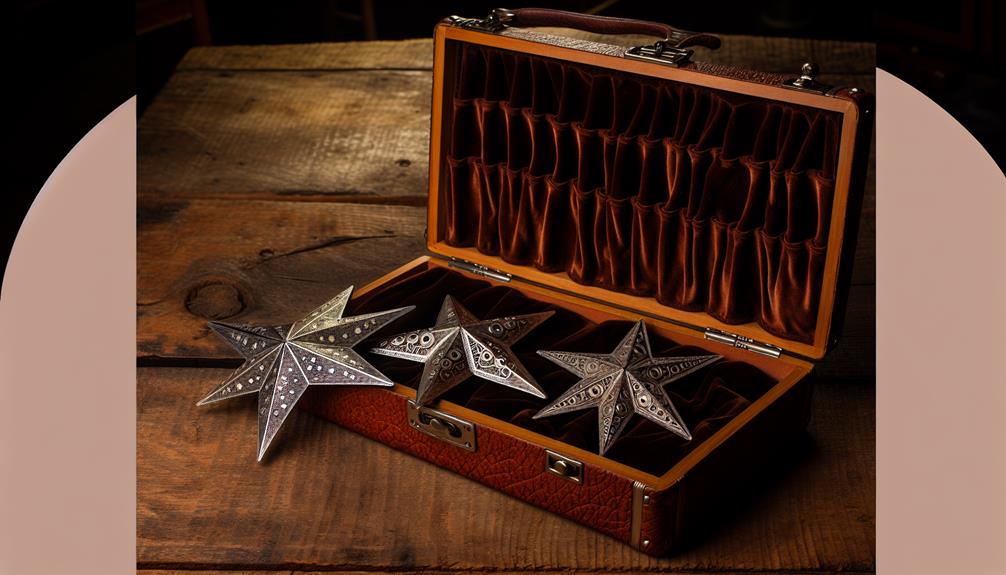
Now that you’ve selected the ideal case for your throwing stars, maintaining them in top condition ensures they last as long as possible and perform well. Proper care involves both effective cleaning techniques and smart storage solutions. Here’s a straightforward guide to keep your throwing stars ready and reliable:
For a deeper clean, use a mild soap and water solution, but make sure you dry them thoroughly to prevent rust.
If you spot nicks or corrosion, address these issues immediately to prevent further deterioration.
The carrying case should have individual slots for each star to prevent them from knocking into each other, which can cause damage.
This is especially important if you live in a humid climate or store your case in a damp location.
Taking these steps will help ensure your throwing stars are always in prime condition.
Refining your throwing technique can dramatically boost your proficiency with throwing stars. To get started, you’ll want to establish a consistent stance. Align your feet shoulder-width apart and keep your body relaxed. Focus on the grip; your fingers should be firm but not too tight, allowing the star to leave your hand smoothly.
Next, integrate varied throwing techniques into your practice routines. Don’t just stick to one style. Experiment with different grips and release methods to find what works best for you. This variation not only keeps the practice interesting but also prepares you for different scenarios.
Setting up specific targets and gradually increasing the distance as you improve is crucial. Start close to build confidence and gradually move back as your accuracy increases.
You can’t take throwing stars on airplanes due to strict airport security rules.
It’s about throwing star safety and ensuring everyone’s security on flights. If you’re caught with them, you could face serious penalties.
Always check the airline’s prohibited items list before flying to avoid any issues.
Consider shipping them to your destination or leaving them at home to ensure you comply with aviation regulations and maintain safety.
No, throwing stars aren’t legal in all U.S. states. Their legality varies widely, and it’s crucial you check your local laws.
Given their history as weapons and the range of materials they’re made from, some states classify them under concealed weapons or specific prohibitions.
Before you consider owning or carrying a throwing star, make sure you’re not inadvertently breaking the law. Always stay informed and compliant with state regulations.
You may wonder if you need a special permit for your throwing stars. It largely depends on local laws, which vary widely.
Throwing star history shows they were often unregulated traditional weapons, but today, safety concerns lead to stricter rules. It’s best to check your state’s laws to see if a permit is required.
You might wonder if you can legally buy throwing stars as a minor.
Generally, due to age restrictions and safety concerns, it’s unlikely you’ll be able to purchase them. Most places have strict laws about selling weapons to minors, and throwing stars often fall under this category.
You’d usually need to be at least 18 years old. Always check your local laws to make sure you’re complying with regulations.
Yes, there are competitions for throwing star accuracy.
You’ll find events both nationally and internationally where enthusiasts gather to showcase their skills.
These competitions often have specific rules regarding throwing techniques and equipment.
Participants must adhere to these guidelines to ensure fair play and safety.
It’s a great way to meet others who share your interest and to see how your skills stack up against fellow throwing star enthusiasts.
Now that you’re equipped with knowledge about throwing stars and their cases, you’re set to choose wisely. Remember, the right case not only protects your stars but also enhances your practice. Opt for durable materials and secure locks, and always handle your stars with care. Regular maintenance will keep them in top shape. Your commitment to safety and proper storage will ensure you get the best out of your practice while keeping safety a priority.
